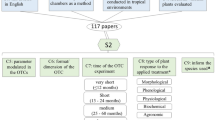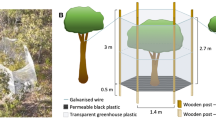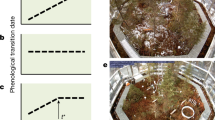Abstract
Passive chambers are used to examine the impacts of summer warming in Antarctica but, so far, impacts occurring outside the growing season, or related to extreme temperatures, have not been reported, despite their potentially large biological significance. In this review, we synthesise and discuss the microclimate impacts of passive warming chambers (closed, ventilated and Open Top Chamber—OTC) commonly used in Antarctic terrestrial habitats, paying special attention to seasonal warming, during the growing season and outside, extreme temperatures and freeze–thaw events. Both temperature increases and decreases were recorded throughout the year. Closed chambers caused earlier spring soil thaw (8–28 days) while OTCs delayed soil thaw (3–13 days). Smaller closed chamber types recorded the largest temperature extremes (up to 20°C higher than ambient) and longest periods (up to 11 h) of above ambient extreme temperatures, and even OTCs had above ambient temperature extremes over up to 5 consecutive hours. The frequency of freeze–thaw events was reduced by ~25%. All chamber types experienced extreme temperature ranges that could negatively affect biological responses, while warming during winter could result in depletion of limited metabolic resources. The effects outside the growing season could be as important in driving biological responses as the mean summer warming. We make suggestions for improving season-specific warming simulations and propose that seasonal and changed temperature patterns achieved under climate manipulations should be recognised explicitly in descriptions of treatment effects.





Similar content being viewed by others
References
ACIA (2005) Arctic climate impact assessment. Cambridge University Press, New York
Aerts R (2006) The freezer defrosting: global warming and litter decomposition rates in cold biomes. J Ecol 94:713–724
Aerts R, Cornelissen JHC, Dorrepaal E, van Logtestijn RSP, Callaghan TV (2004) Effects of experimentally imposed climate scenarios on flowering phenology and flower production of subarctic bog species. Glob Change Biol 10:1599–1609
Arft AM, Walker MD, Gurevitch J, Alatalo JM, Bret-Harte MS, Dale M, Diemer M, Gugerli F, Henry GHR, Jones MH, Hollister RD, Jónsdóttir IS, Laine K, Lévesque E, Marion GM, Molau U, Mølgaard P, Nordenhäll U, Raszhivin V, Robinson CH, Starr G, Stenström A, Stenström M, Totland Ø, Turner PL, Walker LJ, Webber PJ, Welker JM, Wookey PA (1999) Responses of tundra plants to experimental warming: Meta-analysis of the international tundra experiment. Ecol Monogr 69:491–511
Aronson EL, McNulty SG (2009) Appropriate experimental ecosystem warming methods by ecosystem, objective, and practicality. Agric For Meteorol 149:1791–1799
Ayres E, Nkem JN, Wall DH, Adams BJ, Barrett JE, Simmons BL, Virginia RA, Fountain AG (2010) Experimentally increased snow accumulation alters soil moisture and animal community structure in a polar desert. Polar Biol 33:897–907
Bale JS, Worland MR, Block W (2001) Effects of summer frost exposures on the cold tolerance strategy of a sub-Antarctic beetle. J Insect Physiol 47:1161–1167
Benedict JB (1991) Experiments on lichen growth. 2 Effects of a seasonal snow cover. Arct Alp Res 23:189–199
Block W (1980) Survival strategies in polar terrestrial arthropods. Biol J Linn Soc 14:29–38
Block W (1991) To freeze or not to freeze—invertebrate survival of subzero temperatures. Funct Ecol 5:284–290
Block W, Worland MR, Bale J (1998) Respiratory responses to chilling and freezing in two sub-Antarctic insects. Cryobiology 37:163–166
Bokhorst S, Huiskes A, Convey P, Aerts R (2007a) Climate change effects on organic matter decomposition rates in ecosystems from the Maritime Antarctic and Falkland Islands. Glob Change Biol 13:2642–2653
Bokhorst S, Huiskes A, Convey P, Aerts R (2007b) The effect of environmental change on vascular plant and cryptogam communities from the Falkland Islands and the Maritime Antarctic. BMC Ecol 7. doi:10.1186/1472-6785-1187-1115
Bokhorst S, Ronfort C, Huiskes A, Convey P, Aerts R (2007c) Food choice of Antarctic soil arthropods clarified by stable isotope signatures. Polar Biol 30:983–990
Bokhorst S, Bjerke JW, Bowles FP, Melillo JM, Callaghan TV, Phoenix GK (2008a) Impacts of extreme winter warming in the sub-Arctic: growing season responses of dwarf-shrub heathland. Glob Change Biol 14:2603–2612
Bokhorst S, Huiskes AHL, Convey P, PMv Bodegom, Aerts R (2008b) Climate change effects on soil arthropod communities from the Falkland Islands and the Maritime Antarctic. Soil Biol Biochem 40:1547–1556
Bokhorst S, Bjerke JW, Tømmervik H, Callaghan TV, Phoenix GK (2009) Winter warming events damage sub-Arctic vegetation: consistent evidence from an experimental manipulation and a natural event. J Ecol 97:1408–1415
Bokhorst S, Bjerke JW, Davey M, Taulavuori K, Taulavuori E, Laine K, Callaghan TV, Phoenix GK (2010) Impacts of extreme winter warming events on plant physiology in a sub-Arctic heath community. Physiol Plant 140:128–140
Brown SJ, Caesar J, Ferro CAT (2008) Global changes in extreme daily temperature since 1950. J Geophys Res Atmos 113:11
Christensen JH, Hewitson B, Busuioc A, Chen A, Gao X, Held I, Jones R, Kolli RK, Kwon WT, Laprise R, Magaña Rueda V, Mearns L, Menéndez CG, Räisänen J, Rinke A, Sarr A, Whetton P (2007) Regional climate projections. Climate change 2007: the physical science basis. In: Solomon S, Qin D, Manning M et al (eds) Contribution of working group I to the fourth assessment report of the intergovernmental panel on climate change. Cambridge University Press, Cambridge, pp 847–940
Cockell CS, Horneck G, Rettberg P, Facius R, Gugg-Helminger A (2002) Influence of snow and ice covers on UV exposure of Antarctic microbial communities—dosimetric studies. Journal of Photochemical Photobiology 68:23–32
Convey P (2010) Life history adaptations to polar and alpine environments. In: Denlinger DL, Lee RE (eds) Insects at low temperature. Cambridge University Press, Cambridge, pp 297–322
Convey P, Wynn-Williams DD (2002) Antarctic soil nematode response to artificial climate amelioration. Eur J Soil Biol 38:255–259
Convey P, Pugh PJA, Jackson C, Murray AW, Ruhland CT, Xiong FS, Day TA (2002) Response of Antarctic terrestrial microarthropods to long-term climate manipulations. Ecology 83:3130–3140
Convey P, Block W, Peat HJ (2003) Soil arthropods as indicators of water stress in Antarctic terrestrial habitats? Glob Change Biol 9:1718–1730
Convey P, Bindschadler RA, di Prisco G, Fahrbach E, Gutt J, Hodgson DA, Mayewski P, Summerhayes CP, Turner J (2009) Antarctic climate change and the environment. Antarct Sci 21:541–563
Davey MC (1989) The effects of freezing and desiccation on photosynthesis and survival of terrestrial Antarctic algae and cyanobacteria. Polar Biol 10:29–36
Davey MC, Rothery P (1997) Interspecific variation in respiratory and photosynthetic parameters in Antarctic bryophytes. New Phytol 137:231–240
Day TA, Ruhland CT, Grobe CW, Xiong F (1999) Growth and reproduction of Antarctic vascular plants in response to warming and UV radiation reductions in the field. Oecologia 119:24–35
Day TA, Ruhland CT, Xiong FS (2008) Warming increases aboveground plant biomass and C stocks in vascular-plant-dominated Antarctic tundra. Glob Change Biol 14:1827–1843
Day TA, Ruhland CT, Strauss SL, Park JH, Krieg ML, Krna MA, Bryant DM (2009) Response of plants and the dominant microarthropod, Cryptopygus antarcticus, to warming and contrasting precipitation regimes in Antarctic tundra. Glob Change Biol 15:1640–1651
Debevec EM, MacLean SFJ (1993) Design of greenhouses for the manipulation of temperature in tundra plant communities. Arct Alp Res 25:56–62
Freckman DW, Virginia RA (1997) Low-diversity Antarctic soil nematode communities: distribution and response to disturbance. Ecology 78:363–369
Gaines SD, Denny MW (1993) The largest, smallest, highest, lowest, longest, and shortest—extremes in ecology. Ecology 74:1677–1692
Goddard DG (1982) Feeding biology of free-living acari at Signy Island, South Orkney Islands. Brit Ant Survey Bull 52:290–293
Godfree R, Roberston B, Bolger T, Carnegie M, Young A (2011) An improved hexagon open-top chamber system for stable diurnal and nocturnal warming and atmospheric carbon dioxide enrichment. Glob Change Biol 17:439–451
Hawes I (1990) Effects of freezing and thawing on a species of Zygnema (Chlorophyta) from the Antarctic. Phycologia 29:326–331
Hayward SAL, Worland MR, Convey P, Bale JS (2003) Temperature preferences of the mite, Alaskozetes antarcticus, and the collembolan, Cryptopygus antarcticus from the maritime Antarctic. Physiol Entomol 28:114–121
Henry HAL (2007) Soil freeze-thaw cycle experiments: trends, methodological weaknesses and suggested improvements. Soil Biol Biochem 39:977–986
Hodkinson ID, Coulson SJ, Webb NR, Block W (1996) Can high Arctic soil microarthropods survive elevated summer temperatures? Funct Ecol 10:314–321
Hodkinson ID, Webb NR, Bale JS, Block W, Coulson SJ, Strathdee AT (1998) Global change and Arctic ecosystems: conclusions and predictions from experiments with terrestrial invertebrates on Spitsbergen. Arct Alp Res 30:306–313
Huiskes AHL, Lud D, Moerdijk-Poortvliet TCW (2001) Field research on the effects of UV-B filters on terrestrial Antarctic vegetation. Plant Ecol 154:75–86
Kappen L (2000) Some aspects of the great success of lichens in Antarctica. Antarct Sci 12:314–324
Kappen L, Sommerkorn M, Schroeter B (1995) Carbon acquisition and water relations of lichens in polar regions—potentials and limitations. Lichenologist 27:531–545
Karl TR, Kukla G, Razuvayev VN, Changery MJ, Quayle RG, Heim RR, Easterling DR, Fu CB (1991) Global warming—evidence for asymmetric diurnal temperature change. Geophys Res Lett 18:2253–2256
Kennedy AD (1993) Water as a limiting factor in the Antarctic terrestrial environment—a biogeographical synthesis. Arct Alp Res 25:308–315
Kennedy AD (1994) Simulated climate-change—a field manipulation study of polar microarthropod community response to global warming. Ecography 17:131–140
Kennedy AD (1995) Simulated climate change are passive greenhouses a valid microcosm for testing biological effects of environmental perturbations. Glob Change Biol 1:29–42
Kennedy AD (1996) Antarctic fellfield response to climate change: a tripartite synthesis of experimental data. Oecologia 107:141–150
Kimball BA, Conley MM, Wang S, Lin X, Luo C, Morgan J, Smith D (2008) Infrared heater arrays for warming ecosystem field plots. Glob Change Biol 14:309–320
Leather SR, Walters KFA, Bale JS (1995) The Ecology of insect overwintering. Cambridge University Press, Cambridge
Lud D, Huiskes AHL, Moerdijk TCW, Rozema J (2001) The effects of altered levels of UV-B radiation on an Antarctic grass and lichen. Plant Ecol 154:87–99
Malmstrom A (2008) Temperature tolerance in soil microarthropods: simulation of forest-fire heating in the laboratory. Pedobiologia 51:419–426
Marchand FL, Verlinden M, Kockelbergh F, Graae BJ, Beyens L, Nijs I (2006) Disentangling effects of an experimentally imposed extreme temperature event and naturally associated desiccation on Arctic tundra. Funct Ecol 20:917–928
Marion GM, Henry GHR, Freckman DW, Johnstone J, Jones G, Jones MH, Levesque E, Molau U, Molgaard P, Parsons AN, Svoboda J, Virginia RA (1997) Open-top designs for manipulating field temperature in high-latitude ecosystems. Glob Change Biol 3:20–32
Marshall DJ, Newton IP, Crafford JE (1995) Habitat temperature and potential locomotor-activity of the continental antarctic mite, Maudheimia-Petronia Wallwork (Acari, Oribatei). Polar Biol 15:41–46
McGaughran A, Redding GP, Stevens MI, Convey P (2009) Temporal metabolic rate variation in a continental Antarctic springtail. J Insect Physiol 55:129–134
Musil CF, Van Heerden PDR, Cilliers CD, Schmiedel U (2009) Mild experimental climate warming induces metabolic impairment and massive mortalities in southern African quartz field succulents. Environ Exp Bot 66:79–87
Nakatsubo T (2002) Predicting the impact of climatic warming on the carbon balance of the moss Sanionia uncinata on a maritime Antarctic island. J Plant Res 115:99–106
Newsham KK, Robinson SA (2009) Responses of plants in polar regions to UVB exposure: a meta-analysis. Glob Change Biol 15:2574–2589
Robinson SA, Wasley J, Tobin AK (2003) Living on the edge—plants and global change in continental and maritime Antarctica. Glob Change Biol 9:1681–1717
Rustad LE, Campbell JL, Marion GM, Norby RJ, Mitchell MJ, Hartley AE, Cornelissen JHC, Gurevitch J (2001) A meta-analysis of the response of soil respiration, net nitrogen mineralisation, and aboveground plant growth to experimental ecosystem warming. Oecologia 126:543–562
Schimel JP, Bilbrough C, Welker JA (2004) Increased snow depth affects microbial activity and nitrogen mineralisation in two Arctic tundra communities. Soil Biol Biochem 36:217–227
Schroeter B (1994) In situ photosynthetic differentiation of the green algal and the cyanobacterial photobiont in the crustose lichen Placopsis contortuplicata. Oecologia 98:212–220
Schroeter B, Kaplan SL, Schulz F, Sancho LG (2000) Seasonal variation in the carbon balance of lichens in the maritime antarctic: long-term measurements of photosynthetic activity in Usnea aurantiaco-atra. In: Davidson W, Howard-Williams C, Broady P (eds) Antarctic ecosystems: models for wider ecological understanding. The Caxton Press, Christchurch, pp 258–262
Shaver GR, Canadell J, Chapin FS, Gurevitch J, Harte J, Henry G, Ineson P, Jonasson S, Melillo J, Pitelka L, Rustad L (2000) Global warming and terrestrial ecosystems: a conceptual framework for analysis. Bioscience 50:871–882
Simmons BL, Wall DH, Adams BJ, Ayres E, Barrett JE, Virginia RA (2009) Long-term experimental warming reduces soil nematode populations in the McMurdo Dry Valleys, Antarctica. Soil Biol Biochem 41:2052–2060
Sinclair BJ (2002) Effects of increased temperatures simulating climate change on terrestrial invertebrates on Ross Island, Antarctica. Pedobiologia 46:150–160
Sinclair BJ, Chown SL (2005) Deleterious effects of repeated cold exposure in a freeze-tolerant sub-Antarctic caterpillar. J Exp Biol 208:869–879
Sinclair BJ, Klok CJ, Scott MB, Terblanche JS, Chown SL (2003a) Diurnal variation in supercooling points of three species of Collembola from Cape Hallett, Antarctica. J Insect Physiol 49:1049–1061
Sinclair BJ, Vernon P, Klok CJ, Chown SL (2003b) Insects at low temperatures: an ecological perspective. Trends Ecol Evol 18:257–262
Sinclair BJ, Terblanche JS, Scott MB, Blatch GL, Klok CJ, Chown SL (2006) Environmental physiology of three species of Collembola at Cape Hallett, North Victoria Land, Antarctica. J Insect Physiol 52:29–50
Smith RIL (1994) Vascular plants as bioindicators of regional warming in Antarctica. Oecologia 99:322–328
Sømme L (1986) Ecology of Cryptopygus sverdrupi (Insecta: Collembola) from Dronning Maud Land, Antarctica. Polar Biol 6:179–184
Sturm M, Schimel J, Michaelson GJ, Welker JA, Oberbauer SF, Liston GE, Fahnestock JT, Romanovsky VE (2005) Winter biological processes could help convert Arctic tundra to shrub land. Bioscience 55:17–26
Tilbrook PJ (1970) The biology of Cryptopygus antarcticus. In: Holdgate MW (ed) Antarctic ecology, vol 2. Academic Press, London, pp 908–919
Treonis AM, Wall DH, Virginia RA (2000) The use of anhydrobiosis by soil nematodes in the Antarctic Dry Valleys. Funct Ecol 14:460–467
Treonis AM, Wall DH, Virginia RA (2002) Field and microcosm studies of decomposition and soil biota in a cold desert soil. Ecosystems 5:159–170
Turner J, Bindschadler R, Convey P, di Prisco G, Fahrbach E, Gutt J, Hodgson D, Mayewski P, Summerhayes C (2009) Antarctic climate change and the environment. Scientific committee on Antarctic research. Victoire Press, Cambridge
Wan SQ, Xia JY, Liu WX, Niu SL (2009) Photosynthetic overcompensation under nocturnal warming enhances grassland carbon sequestration. Ecology 90:2700–2710
Webb NR, Coulson SJ, Hodkinson ID, Block W, Bale JS, Strathdee AT (1998) The effects of experimental temperature elevation on populations of cryptostigmatic mites in high Arctic soils. Pedobiologia 42:298–308
Wipf S, Rixen C (2010) A review of snow manipulation experiments in Arctic and alpine tundra ecosystems. Polar Res 29:95–109
Wookey PA, Parsons AN, Welker JM, Potter JA, Callaghan TV, Lee JA, Press MC (1993) Comparative responses of phenology and reproductive development to simulated environmental-change in sub-arctic and high arctic plants. Oikos 67:490–502
Wynn-Williams DD (1992) BIOTAS Manual of methods for Antarctic terrestrial and freshwater research. Scientific Committee on Antarctic Research
Wynn-Williams DD (1996) Response of pioneer soil microalgal colonists to environmental change in Antarctica. Microb Ecol 31(2):177–188
Xia J, Han Y, Zhang Z, Wan S (2009) Effects of diurnal warming on soil respiration are not equal to the summed effects of day and night warming in a temperate steppe. Biogeosciences 6:1361–1370
Xiong FS, Ruhland CT, Day TA (1999) Photosynthetic temperature response of the Antarctic vascular plants Colobanthus quitensis and Deschampsia antarctica. Physiol Plant 106:276–286
Young SR, Block W (1980) Some factors affecting metabolic-rate in an Antarctic Mite. Oikos 34:178–185
Zwally HJ, Giovinetto MB, Li J, Cornejo HG, Beckley MA, Brenner AC, Saba JL, Yi DH (2005) Mass changes of the Greenland and Antarctic ice sheets and shelves and contributions to sea-level rise: 1992–2002. J Glaciol 51:509–527
Acknowledgments
This work is an output of the IPY project TARANTELLA (Rilland the Netherlands 2006). We thank these colleagues for their insights and access to data. Research was financially supported by the Netherlands Polar Programme (NPP-NWO 851.20.016), BAS ‘Polar Science for Planet Earth’ core science programme, Antarctica, New Zealand, the National Geographic Society’s Committee for Research and Exploration, and the University of Otago, French Polar Institute (IPEV through Programmes 136 ECOBIO and 405 DIVCRO), the CNRS (Zone Atelier Recherche sur l’Environnement Antarctique et Subantarctique), the NSF OPP, and the McMurdo LTER. Thanks to many field assistants and David Wharton for support and discussion. Data from Signy and Alexander Island (closed and ventilated chambers) were provided by the British Antarctic Survey, Antarctic Microclimate Data (GB/NERC/BAS/AEDC/00002). This paper contributes to the SCAR ‘Evolution and Biodiversity in Antarctica’ scientific research programme.
Author information
Authors and Affiliations
Corresponding author
Electronic supplementary material
Below is the link to the electronic supplementary material.
300_2011_997_MOESM2_ESM.tif
Effect of chamber types on monthly mean soil surface temperatures in the Antarctic. Temperature difference between chambers and control outside is shown on the y-axis. Chamber types: closed chambers (a-d), ventilated chambers (e and f), and OTCs (g-j) (TIFF 1547 kb)
300_2011_997_MOESM3_ESM.tif
Monthly mean, minimum and maximum soil temperatures at 5 cm depth with chamber and control plots. Range bars are minimum and maximum monthly temperatures, grey bars are chambers and the black with wider end caps are control values. Note that the chamber data points are slightly offset from the x-axis (TIFF 1318 kb)
300_2011_997_MOESM4_ESM.tif
Monthly mean, minimum and maximum soil surface temperatures with chamber and control plots. Range bars are minimum and maximum monthly temperatures, grey bars are chambers and the black with wider end caps are control values. Note that the chamber data points are slightly offset from the x-axis (TIFF 1449 kb)
300_2011_997_MOESM5_ESM.tif
Freeze–thaw events in and outside warming chambers in the Antarctic throughout the year. Freeze–thaw events were calculated from hourly data obtained from temperature sensors at the soil surface. Chamber types: closed chambers (a-d), ventilated chambers (e and f), and OTCs (g-j) (TIFF 1521 kb)
Rights and permissions
About this article
Cite this article
Bokhorst, S., Huiskes, A., Convey, P. et al. Microclimate impacts of passive warming methods in Antarctica: implications for climate change studies. Polar Biol 34, 1421–1435 (2011). https://doi.org/10.1007/s00300-011-0997-y
Received:
Revised:
Accepted:
Published:
Issue Date:
DOI: https://doi.org/10.1007/s00300-011-0997-y




